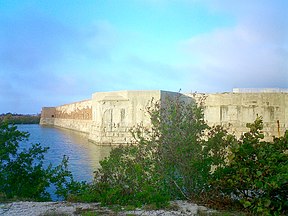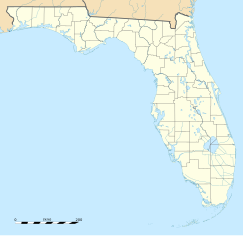Fort Zachary Taylor
| Fort Zachary Taylor | ||
|---|---|---|
| National Register of Historic Places | ||
| National Historic Landmark | ||
|
Fort Zachary Taylor with moat |
||
|
|
||
| location | Key West , Monroe County , Florida | |
| Coordinates | 24 ° 32 ′ 51 ″ N , 81 ° 48 ′ 36 ″ W | |
| Built | 1845-66 | |
| NRHP number | 71000244 | |
| Data | ||
| The NRHP added | March 11, 1971 | |
| Declared as an NHL | May 31, 1973 | |
The Fort Zachary Taylor was a coastal fortification of the US Army off the island of Key West in the US state of Florida . The fort was an important US base in the second half of the 19th century, but was never engaged in direct combat operations. Fort Zachary Taylor Historic State Park is open to the public.
history
Key West's military history begins in 1822 after the Florida Territory fell to the United States and the US Navy stationed a garrison there to combat piracy. Construction of the fort began in June 1845 when the Florida Territory became the 27th state in the United States. The fort was one of the forts that were built from the mid-19th century to defend the southeastern coast of the United States. On November 4, 1850, the fortress was named after Zachary Taylor , the 12th President of the United States, who died in office on July 9, 1850. The completion of the fortress, similar to the neighboring Fort Jefferson on the Dry Tortugas , was delayed in the 1850s due to the fort's remote location, shortages of materials and workers, yellow fever and hurricanes . Before the beginning of the Civil War , John Brannan , an officer in the Key West garrison, occupied the almost completed fort with his troops, thereby securing it for the northern states. During the Civil War, the fortress served as the headquarters of a US squadron that blocked the eastern part of the Gulf of Mexico for Confederate ships and raised over 300 blockade breakers during the war . The fortress itself was not completed until after the Civil War ended in 1866, but the cannons already installed, with a caliber of up to 10 inches (10.4 cm) in caliber, were sufficient as a deterrent so the Confederate fleet did not attack Key West.
From 1889 the fortress was expanded as part of the building program named after the then Minister of War Endicott . During the Spanish-American War , the fortress was again used as a coastal artillery position. During the First and Second World Wars , it served as a training ground for US troops. The fortress was modernized repeatedly until the army abandoned the facility in 1947 and handed it over to the US Navy . The US Navy used the fort as a warehouse and scrapyard for the adjacent Key West submarine base. Starting in 1968, volunteers dug up the Civil War-era buried cannons, which resulted in the former fort being inscribed on the National Register of Historic Places in 1971 . Two years later, on May 31, 1973, Fort Zachary Taylor was recognized as a National Historic Landmark . In 1976 the facility was transferred to the Florida State Park Service, which opened it to the public as a state park in July 1985 .
investment
Originally the fort was on a shoal 350 meters off the coast of Key West. The fort consisted of a trapezoidal structure with 1.5 meters thick walls made of bricks, four bastions and a moat facing the island. On the three sides of the lake, the complex consisted of three-story casemates with gun batteries; in the courtyard there was a three-story barracks. An originally planned casemate to face the island and thus against possible land attacks was never built. During the Civil War, the fortress was armed with 140 cannons, including the most modern Parrot guns and with 25.4 cm Rodman cannons, the largest guns available in the northern states . 450 men were planned for the garrison. The sanitary facilities, which were flushed by the tides , and a seawater desalination system for the drinking water supply of the fortress were modern for the time . A dam connected the fortress to Key West Island. To support the coastal defense, two Martello towers with 14 cannons each were built on the east coast of Key West . During the Endicott construction program in 1889, the fortress was modernized, for which the two upper floors of the complex were demolished in order to offer a smaller attack surface. The old casemates were filled with sand, the old muzzle-loading cannons were used as filler material or were walled up with it to make room for the new guns. Between 1897 and 1904 two new batteries with two 30.5 cm guns and two 7.6 cm guns were installed in the fort, and eight more batteries with 24 guns were built in the vicinity of the fort, one of them in one of the old Martello towers . At the beginning of the Second World War, these guns were long out of date and were dismantled; instead, some light anti-aircraft and anti-aircraft guns , searchlights and radar systems were installed.
literature
- Paul Taylor: Discovering the Civil War in Florida: a reader and guide . Sarasota, Fla .:, Pineapple Press, 2001, ISBN 1-56164-235-5
- Michael Strutin: Florida State Parks: A Complete Recreation Guide . Seattle: Mountaineers Books 2000, ISBN 0-89886-731-2
Web links
- Website of the Fort Zachary Taylor Museum
- State Park website
- Fort Taylor on FortWiki
- Fort Zachary Taylor on the United States Geological Survey's Geographic Names Information System
Individual evidence
- ^ Fort Zachary Taylor in the National Register Information System. National Park Service , accessed August 8, 2017.
- ↑ Listing of National Historic Landmarks by State: Florida. National Park Service , accessed July 20, 2019.


